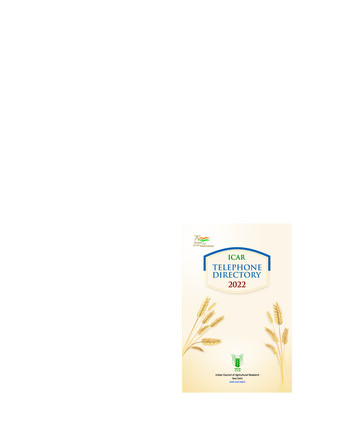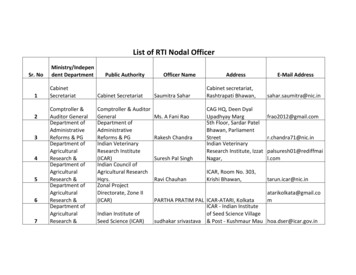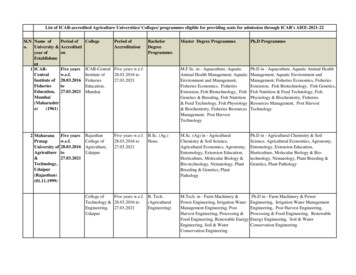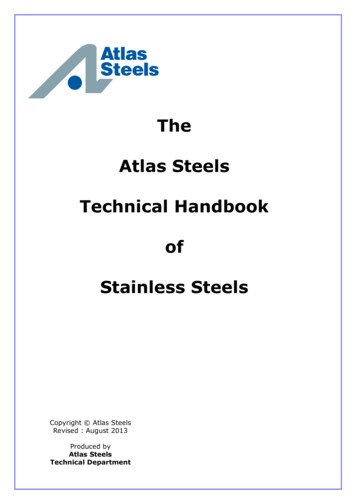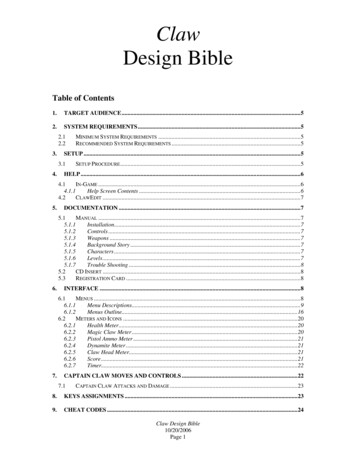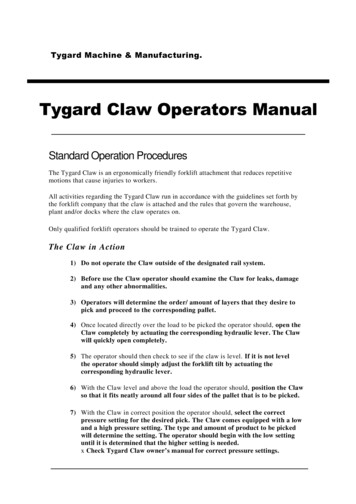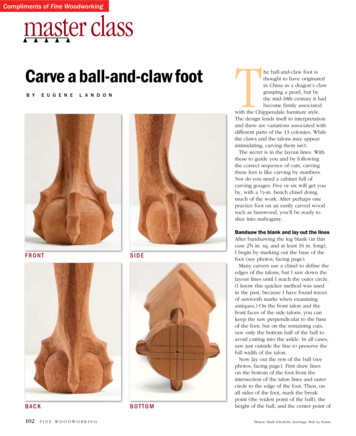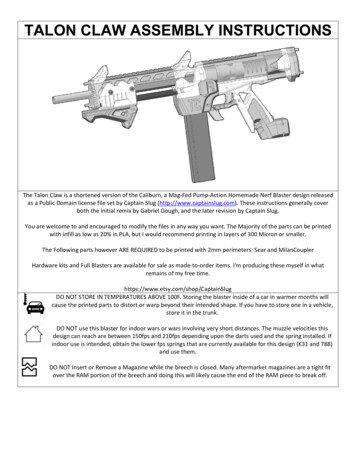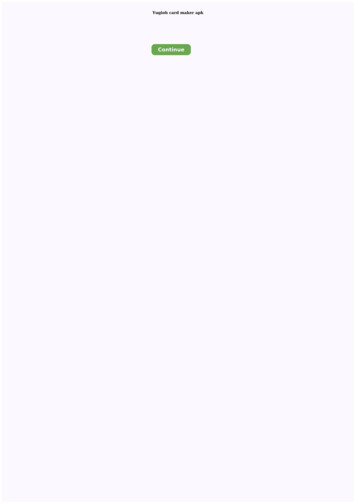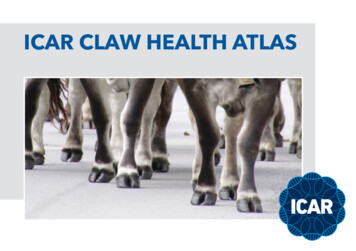
Transcription
ICAR CLAW HEALTH ATLAS
Publishing InformationTitle of the Series: ICAR Technical SeriesTitle of the Issue: ICAR Claw Health AtlasEditors: ICAR Working Group on Functional Traits (ICAR WGFT) and International Claw Health Experts(see page 6-7)Coordination of work: Christa Egger-DannerResponsible for harmonized descriptions / Citation of the ICAR Claw Health Atlas:Egger-Danner, C., Nielsen, P., Fiedler, A., Müller, K., Fjeldaas, T., Döpfer, D., Daniel, V., Bergsten, C., Cramer, G.,Christen, A.-M., Stock, K. F., Thomas, G., Holzhauer, M., Steiner, A., Clarke, J., Capion, N., Charfeddine, N.,Pryce, J.E., Oakes, E., Burgstaller, J., Heringstad, B., Ødegård, C. and J. Koflerhttp://www.icar.org/Documents/ICAR Claw Health Atlas.pdfLayout and design: Franziska Egger, Hollenstein, AustriaEditing of text and pictures: John Cole, USA and Johann Kofler, AustriaPublisher: ICAR, Via Savoia 78, Scala A, Int. 3, 00191, Rome, Italy; Tel: 39 06 85 237 1; Email: icar@icar.orgCopyright by: ICAR, Via Savoia 78, Scala A, Int. 3, 00191, Rome, ItalyISSN: 92-95014-14-6ISBN: 92-95014-18Edition: First edition, June 2015
3Table of ContentsForeword4Introduction5Authors and Contributors6Overview of Foot and Claw Disorders9List of Pictures44 Pesenhofer, AUT
4ForewordICAR is an international organisation with the mission of promoting the development and improvement of performancerecording and genetic evaluation of farm livestock. Our members are animal recording organisations from around theworld and associates who provide services to the animal recording industry. Our eighteen technical Groups, each ofwhich focuses on specific aspects of animal recording or genetic evaluation, carry out much of our work. The work of ourGroups generally covers: standards & guidelines, communications, surveys, and innovation. Their output is available fromthe ICAR website (http://www.icar.org/) and is reported at the annual ICAR meetings. ICAR is particularly appreciative ofthe large amount of work undertaken by the experts who provide their time and knowledge, free of charge, to developinternational standards and guidelines for animal recording. As a consequence of this work, the information availablefrom ICAR’s members around the world is being used to help farmers make decisions leading to a more efficient animalproduction sector worldwide.The ICAR Functional Traits Working Group (ICAR WGFT) is particularly active and has focused on a range of very importanttraits in dairy cattle including: fertility, udder health, and, most recently, feet and legs. This work is part of ICAR’s strategyfor helping its members to provide better services to farmers and to facilitate the genetic improvement of farmed livestock,particularly dairy cattle. For the first time we now have an international Atlas and coding system for claw traits in dairycattle. This represents a major step forward in ensuring the incidence of claw defects affecting animal health, welfare, andproductivity can be reduced in the future.ICAR is focused on continuous improvement and welcomes all feedback on how it can improve its services and in particularthe quality of its standards and guidelines.Hans WilminkICAR President
5IntroductionAwareness of the importance of a properly functioning locomotor system to bovine health and welfare has increasedaround the world. Several countries have recently introduced electronic systems to routinely record foot and claw disordersin dairy cattle and many more countries are developing plans or have committed to begin recording in the near future. Thismotivated the ICAR working group for functional traits to prioritize foot and claw health and to work with internationallyrecognized claw experts to develop best practices for data recording. This collaboration is intended to complement existingresearch on specific aspects of the claws and feet of dairy cattle, focusing solely on the standardization and harmonizationof data recording. The harmonized descriptions are the result of fruitful interdisciplinary collaboration among many expertswith varying backgrounds (claw health experts, hoof trimmers, bovine practitioners, geneticists), ensuring comprehensivecoverage of theoretical and applied needs. It is designed to provide a tool for practitioners and hoof trimmers and presentsguidelines for the recording of important conditions affecting the claw health of cattle. Descriptive trait definitions are usedto ensure that accurate classifications are made, which will support the collection of comparable and high-quality datawithin and across countries to support many activities (e.g., genetic evaluation purposes). The authors and contributors tothe ICAR Claw Health Atlas hope that the compiled material will support the improved recording of foot and claw disordersand provide a valuable tool for improving the health and welfare of dairy cattle.The authors and contributors of the ICAR Claw Health Atlas Nielsen, DK
6Authors and ContributorsAustriaJohann Burgstaller, University Clinic for Ruminants,University of Veterinary Medicine, ViennaChrista Egger-Danner, ZuchtData EDV-DienstleistungenGmbH, ViennaJohann Kofler, University Clinic for Ruminants, Universityof Veterinary Medicine, ViennaRobert Pesenhofer, Federation of Austrian Hoof Trimmers,HitzendorfAustraliaJakob Malmo, Maffra Veterinary Centre, MaffraErika Oakes, Dairy Australia, Southbank, VictoriaJennie Pryce, Department of Environment and PrimaryIndustries and La Trobe University, Agribio, Bundoora,VictoriaBelgiumNicolas Gengler, Université de Liège - Gembloux AgroBio Tech, GemblouxCanadaAnne-Marie Christen, Valacta, QuébecVictor Daniel, Vic‘s Custom Clips est. 1984, QualityBovine Hoof Care, OntarioPaul R. Greenough, Professor Emeritus of VeterinarySurgery, University of SaskatchewanFilippo Miglior, Canadian Dairy Network and University ofGuelph, OntarioFrancesca Malchiodi, University of Guelph, OntarioDenmarkNynne Capion, Department of Large Animal Sciences,University of Copenhagen, CopenhagenPia Nielsen, SEGES P/S, AarhusGermanyAndrea Fiedler, bovine practitioner / Association ofCertified Hoof Trimmers (VgK e.V.), MunichKerstin Müller, Veterinary Medicine Faculty,Freie Universität, BerlinKathrin Friederike Stock, vit - VereinigteInformationssysteme Tierhaltung w.V., VerdenFinlandReijo Junni, Environmental Health Office of CentralOstrobothnia, KokkolaElina Paakala, Faba co-op, VantaaFranceJoël Blanchard, Hoof trimmers training team at CFPPA,Le RheuMarc Delacroix, Veterinarian, member of training team atCFFPA, Le Rheu
7Authors and ContributorsJean Prodhomme, Hoof trimmers training team at CFPPA,Le RheuGilles Thomas, Institut de l‘Élevage, ParisIrelandKeelin O‘Driscoll, Teagasc, Moorepark, CorkThe NetherlandsMenno Holzhauser, GD Animal Health, DeventerGerben de Jong, CRV, ArnhemNew ZealandAnna Irwin, DairyNZ, InvercargillNorwayTerje Fjeldaas, Norwegian University of Life Sciences, OsloBjørg Heringstad, Norwegian University of Life Sciences /Geno, ÅsCecilie Ødegard, Geno, ÅsMaren Knappe-Poindecker, Norwegian University of LifeSciences, OsloÅse Margrethe Sogstad, TINE, ÅsSpainNoureddine Charfeddine, Conafe, MadridAdrián González Sagüés, Anka Hoof Care, Orkoien,NavarraPedro Codesido, Seragro, S. Coop. Galega, A CoruñaSwitzerlandAdrian Steiner, University of Bern, Vetsuisse Faculty, BernSwedenChrister Bergsten, Swedish University of AgriculturalSciences, AlnarpKarin Ulvshammar, Växa Sverige, StockholmUnited KingdomAndrew J Bradley, Quality Milk Management Services Ltd,SomersetJonathan Clarke, SKS Foot trimming Services Ltd,Seaford, East SussexMichael Parkinson, Holstein UK, HertsBecky Whay, University of Bristol, School of VeterinarySciences Langford, BristolUnited States of AmericaJohn Cole, Animal Genomics and ImprovementLaboratory, ARS, USDA, BeltsvilleDörte Döpfer, Food Animal Production Medicine, Schoolof Veterinary Medicine, University of Wisconsin inMadison, MadisonGerard Cramer, College of Veterinary Medicine, University ofMinnesota, St. Paul
8 Daniel, CAN
9Overview of Foot and Claw DisordersNameCodeDescriptionSynonymous TermsPAsymmetric clawsACSignificant difference in width, height and/or length betweenouter and inner claw which cannot be balanced by trimming12Concave dorsal wallCDConcave shape of the dorsal wall13Corkscrew clawsCCAny torsion of either the outer or inner claw. The dorsal edge ofthe wall deviates from a straight line14Digital dermatitisDDInfection of the digital and/or interdigital skin with erosion,mostly painful ulcerations and/or perficial dermatitisIDAll kind of mild dermatitis around the claws, that is not classified as digital dermatitisDouble soleDSHeel horn erosionHHEMortellarodisease,Strawberry disease1518Two or more layers of under-run sole hornUnderrun sole19Erosion of the bulbs, in severe cases typically V-shaped,possibly extending to the coriumSlurry heel,Erosio ungulae21Horn fissureHFCrack in the claw wallAxial horn fissureHFAVertical (longitudinal) crack in the inner claw wall23
10Overview of Foot and Claw DisordersNameCodeDescriptionHorizontal hornfissureHFHHorizontal crack in the claw wallVertical horn fissureHFVVertical (longitudinal) crack in the outer or dorsal claw cissor clawsSynonymous TermsP2425Interdigital growth of fibrous tissueCorns, Tyloma,Interdigital fibroma26IPSymmetric painful swelling of the foot commonly accompaniedwith odorous smell with sudden onset of lamenessFoot rot, Foul in thefoot, Interdigitalnecrobacillosis28SCTip of toes crossing each otherSole hemorrhageSHDiffused and/or circumscribed red or yellow discoloration ofthe sole and/or white lineSole hemorrhagediffused formSHDDiffused light red to yellowish discoloration31Sole hemorrhagecircumscribed formSHCClear differentiation between discolored and normal coloredhorn3230Sole bruising
11Overview of Foot and Claw DisordersNameSwelling of coronetand/or bulbCodeDescriptionSWUni- or bilateral swelling of tissue above horn capsule, whichmay be caused by different conditionsUlcerUUlceration of the sole area specified according to localization(zones) such as bulb ulcer, sole ulcer, toe ulcer, toe necrosisSole ulcerSUPenetration through the sole horn exposing fresh or necroticcoriumBulb ulcerBUUlcer located at the bulbToe ulcerTUUlcer located at the toeSynonymous TermsP3335Heel ulcer3637Toe necrosisTNNecrosis of the tip of the toe with involvement of bone tissue38Thin soleTSSole horn yields (feels spongy) when finger pressure is applied40White line diseaseWLSeparation of the white line with or without purulentexudationWhite line fissureWLFSeparation of the white line which remains after balancing bothsoles41White line abscessWLANecro-purulent inflammation of the corium42
12Asymmetric claws (AC)Significant difference in width, height and/or length between outer and inner clawwhich cannot be balanced by trimming Fiedler, GER Capion, DK
13Concave dorsal wall (CD)Concave shape of the dorsal wall Fiedler, GER Thomas, FRA
14Corkscrew claw (CC)Any torsion of either the outer or inner claw. The dorsal edge of the wall deviatesfrom a straight line Kofler, AUT Kofler, AUT
15Digital dermatitis (DD)Infection of the digital and/or interdigital skin with erosion, mostly painful ulcerationsand/or chronic hyperkeratosis/proliferation Müller, GER Kofler, AUT
16Digital dermatitis (DD)Infection of the digital and/or interdigital skin with erosion, mostly painful ulcerationsand/or chronic hyperkeratosis/proliferation Christen, CAN Thomas, FRA
17Digital dermatitis (DD)Infection of the digital and/or interdigital skin with erosion, mostly painful ulcerationsand/or chronic hyperkeratosis/proliferation Fiedler, GER
18Interdigital/ superficial dermatitis (ID)All kind of mild dermatitis around the claws, that is not classified as digital dermatitis Knappe-Poindecker, NOR Bergsten, SWE
19Double sole (DS)Two or more layers of under-run sole horn Bergsten, SWE Kofler, AUT
20Double sole (DS)Two or more layers of under-run sole horn Fjeldaas, NOR
21Heel horn erosion (HHE)Erosion of the bulbs, in severe cases typically V-shaped, possibly extending to thecorium Müller, GER Clarke, UK
22Heel horn erosion (HHE)Erosion of the bulbs, in severe cases typically V-shaped, possibly extending to thecorium Müller, GER Kofler, AUT
23Axial horn fissure (HFA)Vertical (longitudinal) crack in the inner claw wall Malmo, AUS Malmo, AUS
24Horizontal horn fissure (HFH)Horizontal crack in the claw wall Greenough, CAN Greenough, CAN
25Vertical horn fissure (HFV)Vertical (longitudinal) crack in the outer or dorsal claw wall Kofler, AUT
26Interdigital hyperplasia (IH)Interdigital growth of fibrous tissue Kofler, AUT Kofler, AUT
27Interdigital hyperplasia (IH)Interdigital growth of fibrous tissue Kofler, AUT
28Interdigital phlegmon (IP)Symmetric painful swelling of the foot commonly accompanied with odorous smellwith sudden onset of lameness Fiedler, GER Kofler, AUT
29Interdigital phlegmon (IP)Symmetric painful swelling of the foot commonly accompanied with odorous smellwith sudden onset of lameness Müller, GER Junni, FIN
30Scissor claws (SC)Tip of toes crossing each other Bergsten, SWE
31Sole hemorrhage diffused (SHD)Diffused light red to yellowish discoloration Capion, DK Prodhomme, FRA
32Sole hemorrhage circumscribed (SHC)Clear differentiation between discolored and normal colored horn Blanchard, FRA Kofler, AUT
33Swelling of coronet and/or bulb (SW)Uni- or bilateral swelling of tissue above horn capsule, which may be caused bydifferent conditions Kofler, AUT Kofler, AUT
34Swelling of coronet and/or bulb (SW)Uni- or bilateral swelling of tissue above horn capsule, which may be caused bydifferent conditions Kofler, AUT Kofler, AUT
35Sole ulcer (SU)Penetration through the sole horn exposing fresh or necrotic corium Delacroix, FRA Thomas & Prodhomme, FRA
36Bulb ulcer (BU)Ulcer located on the bulb Kofler, AUT Kofler, AUT
37Toe ulcer (TU)Ulcer located at the toe Fjeldaas, NOR Kofler, AUT
38Toe necrosis (TN)Necrosis of the tip of the toe with involvement of bone tissue Clarke, UK Kofler, AUT
39Toe necrosis (TN)Necrosis of the tip of the toe with involvement of bone tissue Delacroix, FRA Delacroix, FRA
40Thin sole (TS)Sole horn yields (feels spongy) when finger pressure is applied Fiedler, GER Fiedler, GER
41White line fissure (WLF)Separation of the white line which remains after balancing both soles Kofler, AUT Nielsen, DK
42White line abscess (WLA)Necro-purulent inflammation of the corium Kofler, AUT Fjeldaas, NOR
43White line abscess (WLA)Necro-purulent inflammation of the corium Kofler, AUT
44List of PicturesBergsten, Christer (SWE): ID P18b; DS P19a; SC P30a;Blanchard, Joël (FRA): SHC P32a;Capion, Nynne (DK): AC P12b; SHD P31a;Christen, Anne-Marie (CAN): DD P16a;Clarke, Jonathan (UK): HHE P21b; TN P38a;Daniel, Victor (CAN): Trimming P8;Delacroix, Marc (FRA): SU P35a; TN P39a,b;Greenough, Paul (CAN): HFH P24a,b;Hausegger, Otto (AUT): Cover picture;Fiedler, Andrea (GER): Trimming P45; AC P12a; CD P13a; DD P17a; IP P28a; TS P40a,b;Fjeldaas, Terje (NOR): DS P20a; TU P37a; WLA P42b;Junni, Reijo (FIN): IP P29b;Knappe-Poindecker, Maren (NOR): ID P18a;
45List of PicturesKofler, Johann (AUT): CC P14a,b; DD P15b; DS P19b; HHE P22b; HFV P25a; IH P26a,b; IH P27a; IP P28b;SHC P32b; SW P33a,b; SW P34a,b; BU P36a,b; TU P37b; TN P38b; WLF P41a; WLA P42a; WLA P43a;Malmo, Jakob (AUS): HFA P23a,b;Müller, Kerstin (GER): DD P15a; HHE P21a; HHE P22a; IP P29a;Nielsen, Pia (DK): Trimming P5; WLF P41b;Pesenhofer, Robert (AUT): Trimming P3;Prodhomme, Jean (FRA): SHD P31b; SU P35b;Thomas, Gilles (FRA): CD P13b; DD P16b; SU P35b; Fiedler, GER
46
with varying backgrounds (claw health experts, hoof trimmers, bovine practitioners, geneticists), ensuring comprehensive coverage of theoretical and applied needs. It is designed to provide a tool for practitioners and hoof trimmers and presents guidelines for the recording of important conditions affecting the claw health of cattle.
